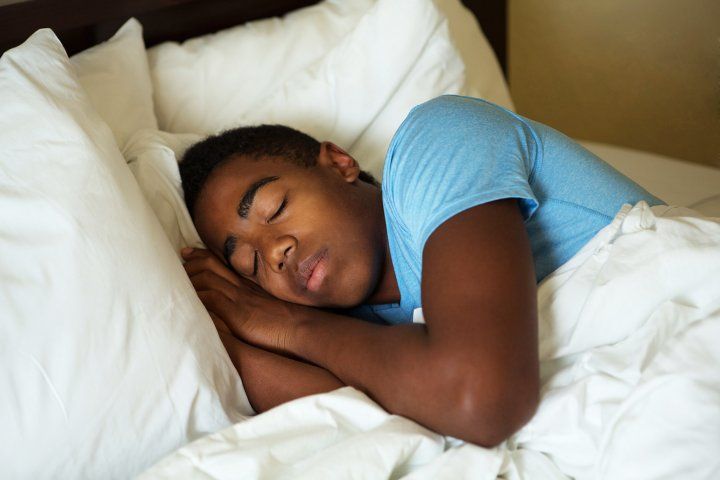
Research indicates that starting school later in the morning yields health and academic benefits for high schoolers, whose natural body clock tends toward late-to-bed, late-to-rise habits. While parents raise concerns about drowsy driving, irritation and impaired school performance, a new study led by researchers at UC San Francisco suggests another reason to push back the start time.
The researchers found that teens with migraines whose high schools started before 8:30 a.m. experienced an average 7.7 headache days per month. This was close to three more headache days than those with later school start times, the researchers reported in their study, which publishes in Headache: The Journal of Head and Face Pain on Nov. 25, 2020.
“Evidence suggests that there is a relationship between sleep and migraine,” said first author Amy Gelfand, MD, a neurologist at the Pediatric Headache Program at UCSF Benioff Children’s Hospitals, noting that 8 percent to12 percent of adolescents suffer from the disease. “Getting adequate sleep and maintaining a regular sleep schedule may reduce the frequency of migraines.”
The American Academy of Sleep Medicine advises that teens get from eight to 10 hours of sleep a night. In recognition of adolescents’ delayed circadian clock, the American Academy of Pediatrics recommends that middle and high schools start no earlier than 8:30 a.m. However, just 18 percent of public middle and high schools adhere to this recommendation, according to the Centers for Disease Control and Prevention.
To quantify what impact, if any, school start times have on migraine frequency, the researchers reached out to high schoolers via social media, offering a $10 gift card to complete a brief survey. Approximately 1,000 9th to 12th graders whose headaches fit the criteria for migraine responded to the survey. They comprised 509 students who started school before 8:30 a.m. and 503 who started school after 8:30 a.m.
Both groups had an average 24-minute commute to school, with the earlier-start group waking up at 6:25 a.m. and beginning school at 7:56 a.m., and the later-start group waking up at 7:11 a.m. and beginning school at 8:43 a.m. Of note, the later-start group went to bed earlier on school nights – on average at 10:19 p.m., versus 10:58 p.m. in the earlier-start group.
While the average number of headache days per month averaged 7.7 days for the earlier-start group and 4.8 days for the later-start group, the difference narrowed to 7.1 and 5.8 days when the researchers adjusted for risk factors such as inadequate sleep and skipping breakfast, as well as for gender, grade, homework volume and migraine medication use. Nevertheless, the 1.3 days difference between the two groups remained significant, said Gelfand, who is affiliated with the UCSF Weill Institute for Neurosciences.
“The magnitude of the effect size in this study is similar to that seen in studies of migraine prevention drugs,” she said. “For example, in a trial of topiramate (Topamax) versus placebo in 12- to 17-year-olds with episodic migraine, those receiving the drug had an average of two migraine days in the last month, compared with 3.5 migraine days for those on placebo – a difference of 1.5 days.”
Similarly, in two studies of adults receiving onabotulinum toxin A (Botox) injections to prevent chronic migraines, the difference between the number of headache days between the two treatment groups and each placebo group was 1.4 days and 2.3 days.
“If our findings are confirmed in future research, shifting to a later high school start time is a modifiable, society-level intervention that could translate to thousands of fewer migraine days and fewer missed days of school for teenagers,” said Gelfand, who will be the new editor-in-chief of Headache in January.
In 2019, California became the first state to legislate that high schools begin no earlier than 8:30 a.m., a change that will be implemented in the 2022-23 academic year. “The COVID-19 pandemic has led to widescale changes in how students attend schools,” said Gelfand. “As we rethink what a typical school day looks like, the time may be ripe for changing school start time as well.”
Co-Authors: Senior author is Isabel Elaine Allen, PhD, of the UCSF Department of Epidemiology and Biostatistics. Co-authors are Sara Pavitt, MD, Alexandra Ross, PhD, Samantha Irwin, MD, Barbara Grimes, PhD, and Remi Frazier of UCSF; Katie Stone, PhD, from UCSF and California Pacific Medical Center; Christina Szperka, MD, from Children’s Hospital of Philadelphia; and Suzanne Bertisch, MD, from Brigham and Women’s Hospital.
Funding: UCSF Research Allocation Program
Disclosures: For a full list of potential conflicts of interest, please refer to the journal.
UCSF Benioff Children’s Hospitals are two leading Bay Area children’s hospitals with longstanding commitments to public service. UCSF Benioff Children’s Hospital San Francisco and UCSF Benioff Children’s Hospital Oakland both have leading pediatric residency programs, unique pediatric subspecialty fellowship programs, a research base for the next generation of discoveries, and expertise in pediatric clinical care, public policy and patient advocacy.
"may" - Google News
November 25, 2020 at 08:29AM
https://ift.tt/3maeYSQ
For Teens with Migraines, Sleeping In (a Bit) May Help - UCSF News Services
"may" - Google News
https://ift.tt/3foH8qu
https://ift.tt/2zNW3tO
Bagikan Berita Ini














0 Response to "For Teens with Migraines, Sleeping In (a Bit) May Help - UCSF News Services"
Post a Comment